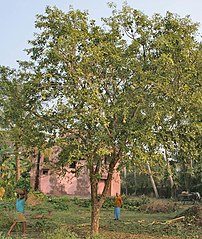Botanical Name : Triphasia trifolia
Family: Rutaceae
Genus: Triphasia
Species: T. trifolia
Kingdom: Plantae
Order: Sapindales
Other scientific Names:Limonia trifolia Burm. f. ,Limonia trifoliata Linn.,Triphasia trifoliata DC. ,Triphasia aurantiola Lour.
Common Names: Sua-sua (Bik.),Suang-kastila (Bik.),Tagimunau (Neg.), Lime-berry (Engl.),Trifoliate limeberry (Engl.),Triphasia (Engl.),Kalamansito (Ilk., Ibn.),Kamalitos (Tag.), Limoncito (Span.),Limonsitong-kastila (Bik.)
Habitat : Triphasia trifolia is native to tropical southeastern Asia in Malaysia and possibly elsewhere.Grows throughout the Philippines, in thickets and settled areas; in some places, abundant.
Description:
It is an evergreen smooth shrub growing to a height of 2 to 3 meters.
The leaves are trifoliate, glossy dark green, each leaflet 2-4 cm long and 1.5-2 cm broad. They have two sharp and slender spines at the base. The short-petioled leaves have three leaflets, ovate to oblong-ovate, the terminal one 2 to 4 cm long; the lateral ones, smaller. The margins are crenate. Flowers are very short-stalked, white, fragrant, and about 1 cm long. Fruit is ovoid, fleshy and red, somewhat resinous, about 12 mm long, similar to a small Citrus fruit.
Cultivation:
It is grown for its edible fruit, and has been widely introduced to other subtropical to tropical regions of the world; it has become naturalized on a number of islands in the tropical Pacific Ocean.
This tree is also considered a weed in other introduced locations.
Edible Uses:
*Fruit is edilbe, raw or cooked.
*Ripe fruit is pleasant and sweet tasting.
*Fruit can be pickled or made into jams.
Medicinal Uses:
Parts utilized :Leaves and fruits.
Constituents and Properties
• Berries are lemon-scented.
• Fragrant white flowers have a scent of orange blossoms.
• Leaves exude a resinous scent when bruised.
• Considered antifungal and antibacterial.
• Study yielded a new bicoumarin from the leaves and stems; the two coumarinic moieties are derivatives of mexoticin and meranzin hydrate.
• From the oil 81 compounds were identified, the main constituent was germacrene B.
Folkloric
*Leaves applied externally for colic, diarrhea, and skin afflictions.
*Fruits used for cough and sore throat.
*Preparation: Peel the fruits and soak overnight lime (apog) water. Rinse, and boil in 1 cup water with 1/2 cup sugar. Rinse and boil a second and third time as preferred, syrupy or candied, using as needed for cough or sore throat.
Studies
• Phenolics / Anti-HSV: Study on the inhibitory effects of phenolic compounds on herpes simplex virus and HIV included 13 coumarins from Triphasia trifolia. The data suggests the bis-hydroxyphenyl structure as a potential target for anti-HSV and HIV drugs development.
• Bicoumarin: Study yielded a new bicoumarin from the leaves and stems of Triphasia trifolia.The two coumarinic moieties are derivatives of mexoticin and meranzin hydrate.
Others Uses:
*Leaves used in making aromatic bath salts.
*Leaves used as cosmetic.
*Cultivated for its ornamental fragrant flower and edible red fruit. Attractive as a garden hedge.
*The Limeberry has been used as a bonsai plant…....CLICK & SEE….
Disclaimer:
The information presented herein is intended for educational purposes only. Individual results may vary, and before using any supplements, it is always advisable to consult with your own health care provider.
Resources:
http://www.stuartxchange.com/Limonsito.html
http://en.wikipedia.org/wiki/Triphasia_trifolia
http://www.tradewindsfruit.com/limeberry.htm
http://www.artofbonsai.org/galleries/worldview06.php


![Reblog this post [with Zemanta]](https://i0.wp.com/img.zemanta.com/reblog_e.png?w=580)












